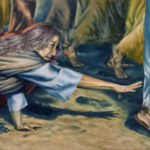THE WHAT, HOW, AND WHY OF GICLEE PRINTS
Yesterday, My Man Jim and I drove down to my hometown of Kilmarnock, Va to pick up work from my framer, and leave with her the last two paintings to be framed. We also took the new pieces to the company which has been shooting the digital images for my reproductions of Women’s Studies. I have a customer who needs a print of “The Woman With An Issue Of Blood.” We needed to talk about several issues concerning this. It was a great shoot for the new work, and a great conversation about the giclee print.
Giclee? What the heck is that? Well, it surely isn’t an off-set lithograph print, which used to be the standard for all art prints mass produced up until the 1990s. It is a somewhat generic term used to describe a print made by an ink jet printing machine.
This is how it works in the simplest of terms. The imagery for giclee printing is shot with a digitized camera, where color adjustments and flaws can be adjusted or removed through a computer screen. The term “giclee” came from a French term which means to spray, squirt or otherwise force liquid onto something, and that is precisely how these prints are made. This printing method was developed in the 1990s with the invention of a state-of-the-art commercial ink jet printer equipped with thousands of tiny nozzles that spray the ink onto the paper or canvas. This allows the tiniest details and intricacies of color to be reproduced truer to the original than any litho process could hope to achieve. As stated earlier, it also allows you to print your work on canvas as well as paper. Canvas, stretched over a frame as an original oil painting would be, looks just like an original. Paper prints require glass for protection from dirt and other accidents, such as exposure to moisture or water, but canvas prints do not.
I can’t conceive of any reason why I would ever again use off-set lithography to produce a print. There are many draw backs to the off-set litho method of printing. First, the prep work and machinery used to print lithos requires one to print a god-awful amount of prints at one time to be economically feasible. Hundreds, or even thousands of them. Storage space for all these prints can become a real issue. Second, all of the costs are up front, and that can break your bank account! It can cost several thousand dollars for a single print edition, and make take years, if at all, to get your money back in sales. Third, they fade. Litho inks are dye based. They are not color-fast when exposed to sunlight or any other light source producing UV rays, such as fluorescent lighting. Everyone has seen the prints in businesses or opposite glass-lined walls that have “gone blue.” The reason? The yellow and red dyes have faded out from over exposure to UV light rays, leaving only the blue, which has a longer wave length. Giclee printing, on the other uses pigment based inks which do not fade. Although giclee prints haven’t been around long enough to stand the test of time, lab testing has proven them to be light fast up 100 years or more. I’ll take that any day! I’ve had too many customers cry for replacements when they hang an expensive lithograph print right in front of their windows. Nowadays, with the energy efficient fluorescent light bulbs becoming the norm in every household, even dark corners of a room are no long safe. One of the best reasons to use the giclee printing process is the ability to print on demand. You don’t have to print (and pay for) the whole edition up front. There are no metal printing plates to break down because everything is digitized and stored on a computer, CD or DVD. If you need one print, you can order one print. If you need five, or ten or 50, you can order those amounts and pay for those amounts. Fourth, As stated earlier, this process also allows you to print your work on canvas as well as paper. Canvas, stretched over a frame as an original oil painting would be, looks just like an original. Paper prints require glass for protection from dirt and other accidents, such as exposure to moisture or water, but canvas prints do not. Technology has indeed made the fine art print business fast and economical for just about anybody!
also allows you to print your work on canvas as well as paper. Canvas, stretched over a frame as an original oil painting would be, looks just like an original. Paper prints require glass for protection from dirt and other accidents, such as exposure to moisture or water, but canvas prints do not. Technology has indeed made the fine art print business fast and economical for just about anybody!
A few words of caution: Research your giclee printer. Make sure they use archival inks and papers. There are many online giclee painters out there who may offer the cheapest prices, but will also give you the cheapest quality of prints. If you want an excellent, long-lasting product, you can get that from a reputable printer who may charge a little more, but will still be very affordable.

Recent Comments